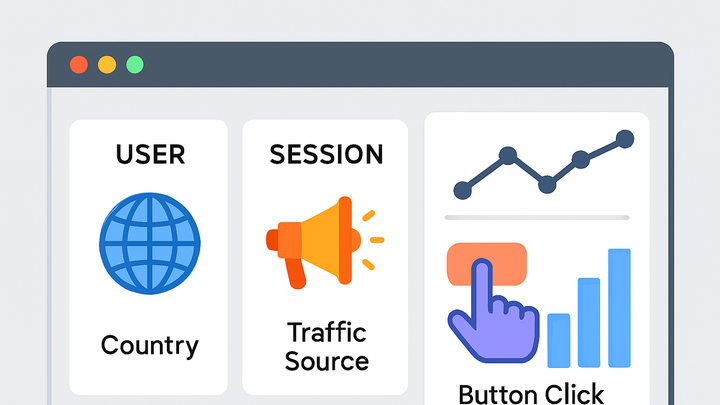Published on 2025-06-22T03:02:20Z
What is a Dimension in Analytics? Examples and Usage
In analytics, a dimension is a descriptive attribute or characteristic of your data that can be used to segment, filter, and analyze that data. Unlike metrics, which are quantitative measurements (e.g., number of sessions or conversions), dimensions provide qualitative context such as ‘page path’, ‘country’, or ‘device type’. By combining dimensions and metrics, analysts can answer questions like ‘Which countries generate the most pageviews?’ or ‘What device types do returning users prefer?’. In Google Analytics 4 (GA4), dimensions are pre-defined (standard) or user-created (custom) and are attached to events or users. In PlainSignal, a cookie-free analytics platform, key dimensions are captured automatically, and you can also send custom variables for more granular insights. Understanding and implementing dimensions correctly is essential for meaningful reporting and data-driven decision making.
Dimension
A dimension is a qualitative attribute in analytics, such as page path or country, used to segment and analyze metrics.
Definition and Key Characteristics
This section covers what a dimension is and why it matters in analytics.
-
Core definition
A dimension is a qualitative attribute or characteristic of an event or user, such as ‘Page Path’, ‘Device Type’, or ‘Country’.
Types of Dimensions
Explore the different categories of dimensions you encounter in analytics platforms.
-
User dimensions
Attributes that describe the user, like ‘Country’, ‘Browser’, or ‘User Type’.
-
Session dimensions
Attributes tied to a session, such as ‘Session Duration’, ‘Traffic Source’, or ‘Landing Page’.
-
Event dimensions
Attributes attached to specific events, for example ‘Button Text’, ‘Video Title’, or ‘Error Code’.
Implementing Dimensions in GA4
Google Analytics 4 offers both standard and custom dimensions to capture and segment data.
-
Standard dimensions
Built-in dimensions provided by GA4, like ‘page_location’, ‘user_medium’, or ‘device_category’. These require no additional setup.
-
Custom dimensions
User-defined dimensions that you register in the GA4 interface and attach via gtag.js or the Measurement Protocol. They have scopes like ‘Event’, ‘User’, or ‘Session’.
Implementing Dimensions in PlainSignal
PlainSignal is a cookie-free analytics tool that collects key dimensions out of the box and supports custom attributes.
-
Default dimensions
PlainSignal automatically tracks dimensions such as ‘page_path’, ‘referrer’, ‘device_type’, and ‘country’ without any configuration.
-
Custom tracking variables
You can send custom attributes via the
data-variablesattribute in the tracking script, for example:<script defer data-do="yourwebsitedomain.com" data-id="0GQV1xmtzQQ" data-api="//eu.plainsignal.com" data-variables='{"plan":"premium","userType":"member"}' src="//cdn.plainsignal.com/plainsignal-min.js"></script>
Best Practices for Using Dimensions
Ensure your dimensions are reliable and actionable by following these guidelines.
-
Maintain consistent naming
Use clear, consistent names for custom dimensions to avoid confusion and ensure clarity across reports.
-
Limit cardinality
Avoid high-cardinality dimensions with too many unique values, which can degrade performance and complicate analysis.
-
Document definitions
Keep a glossary of all custom dimensions, their purpose, and their implementation details for team reference.
